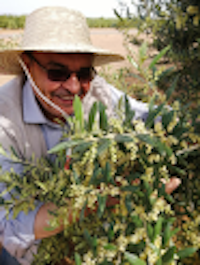Monji MSALLEM PhD (specialty Olive Growing) since 2002, Agriculture Research Director – Professor Retired since April 2018. I start my professional carrier in 1983 as researcher in Olive Institute (Tunisia). I did many international missions of development of Olive Culture with FAO, IOC, OADA, ACSAD, ICARDA. Head of the Executive Agencies of international projects (COI/CFC). Co-editor of national and international catalogs of olive germplasm. Author of more than 100 scientific and technical papers. National Team leader of olive Tree program. Member of Olive Tree Strategy Committee of Tunisia. Technical assistance for farmers, holding, nurseries, oil factories. Organization of seminars and meeting about olive tree. International Consultancy for olive projects in Morocco, Algeria, Libya, Liban, Syria, Oman, Saudia, Turkia, Albania. Actually, permanent consultant of NADEC Olive Project in Saudia (5 millions organic olive trees in SHD and the biggest factory in Middle East (1250 tn/day).
«There was an old proverb that said,
‘They have planted, we eat; we plant, they will eat’,
To illustrate the longevity of the olive tree that was cultivated for generations. The olive have traditionally been a long lived rainfed crop that is well adapted to the Mediterranean climate. The expansion of cultivation was slow with the use of locally selected plant material based on criteria relating to the hardiness and volume of the tree. The plantations were on hills or mountainous areas and made it possible to valorize marginal areas where no other crop could have survived. Popular knowledge conceived techniques for soil protection and conservation. The plantation was exclusively extensive in rainfed areas with low densities. The olive-growing sector provided manual employment for millions of families, particularly in olive harvest. Yields were low and irregular. Empiric technology and low investment were prevailing. Processing was mainly aimed at oil yield and very little at the quality not yet required by consumers. Consumption was limited to the Mediterranean basin with strong competition from seed oils. In addition, there was a total absence of integration in all its forms.
Opinion about the current situation in the sector
Nowadays, the improvement of cultivation systems has become a necessity in view of the human migration from rural to urban and from agriculture to industry and tourism. Thus, the restructuring of several olive groves in the world has been initiated with an orientation towards the intensification and increase of irrigated areas and the mechanization of the harvest as a result of several research programs and technology transfer in agronomy and oil production. In addition, olive oil is considered an important agricultural product for health and its consumption has steadily increased with an enhanced demand for quality parameters. Yields are thus improved and exploitation of olive genetic diversity and breeding are increasingly being developed, with a trend towards packaged mono varietal oils. The sector is evolving in the direction of the value chain, with horizontal and vertical integration and the emergence of an entrepreneurial spirit, particularly under the hyper-intensive system. The olive tree is currently cultivated, produced and consumed in all regions of the world. In the new countries the notion of value chain is taken into account in the assembly of the olive projects and the developers are studying their business plans well before embarking on projects and consequently have several assets to become an olive power thanks to the availability of huge areas of land and water reserves that can attract many investors in both Olive oil and Olive table’s value chains and produce quality with a competitive cost of production.
A new repositioning is predictable in the coming years and new dragons arrive.
Much promotional work remains to be done to increase consumption and absorb future abundant production in the coming years.

